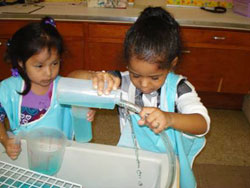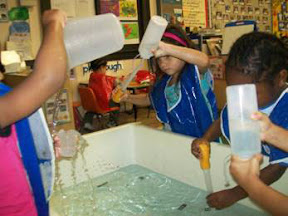By Mary Bigelow
Posted on 2012-06-24
 At an NSTA conference this year, I got really charged up about using more inquiry with my students. But when I look at our curriculum, it’s full of traditional “cookbook” labs that we are required to do. How can I make time for inquiry-based activities?
At an NSTA conference this year, I got really charged up about using more inquiry with my students. But when I look at our curriculum, it’s full of traditional “cookbook” labs that we are required to do. How can I make time for inquiry-based activities?
—Michael, New Mexico
When I was in my undergraduate science methods class, inquiry in science was a key topic. That was many years ago, yet we’re still talking about this. I wonder if it’s because many still may perceive it as an analog situation: do either cookbook labs (in which students simply follow the directions) or full inquiry investigations (which students design and conduct). At first, I struggled with this dichotomy with my middle school students. Were they really “ready” for inquiry?
My “aha” moment came through reading, experience, and reflection: inquiry is not either-or but rather a continuum, depending on the amount of input or scaffolding from the teacher and the level of ownership the students have in the process. In The Many Levels of Inquiry (see the Resource Collection at the end), Bianchi and Bell (2008) describe this continuum:
- Confirmation inquiry: Students are provided with the question and the procedure. The results are known, and there is often a “correct” answer or outcome. Teachers use activities at this level to introduce a tool or practice a procedure such as observation, measurement, or data collection.
- Structured inquiry: Students are given the question and procedure, and they develop their own explanations based on the evidence they collect.
- Guided inquiry: Students are provided with the question to investigate, but they design the procedure and develop explanations of the results (with teacher guidance and feedback).
- Open inquiry: Students formulate the research question, design the methods used to conduct the investigation, and communicate the results.
What differentiates these is the role of the students and teacher in asking questions, designing procedures, collecting and organizing data, and generating explanations and conclusions. The more input the students have, the higher the level of inquiry. The graphic in Inquiry Is Essential (see the Resource Collection) shows the relationship between levels of student self-direction and directions provided by the teacher.
So the good news is you don’t necessarily have to add more activities to the existing curriculum. Even confirmation or “cookbook” labs can be kicked up a notch (as Chef Emeril would say).
One way is to change the title of an activity from a topic to a question. For example, instead of saying, “Today we’re going to learn about the microscope,” you could introduce the activity with a question: “What kinds of microorganisms live in pond water?” Students could practice using the microscope with a few prepared slides of algae or protists. They would practice making wet-mount slides to examine samples of pond water, doing an inventory of species and sketching what they see. My students thought this more interesting and purposeful than the traditional look-at-the-upside-down-e and the worksheet on naming the parts. I found that it helps to put learning about tools and techniques into the context in which they are used, rather than as isolated activities. Students can then see a reason for using them.
There are other ways to increase the amount of student input into an existing investigation. You could give students a procedure and ask them to fill out a requisition form listing the materials and equipment they would need. Rather than using a prepared handout, they could brainstorm ways to display data or communicate their results. Students could add other questions to extend the activity. I observed a teacher who shared the first few steps of a procedure and then asked the class (using a think-pair-share), “What should we do next?” You could also ask students about what they are doing and what they observe as they conduct an activity.
In my own middle school classes, most of the activities were at the first three levels. But we did several projects at the open inquiry level, often as a culminating investigation. For example, in a unit on plants, I asked groups of students to design controlled experiments to determine factors that affect plant growth.
I’ve created a Resource Collection of journal articles related to inquiry and with examples at various grade levels and topics. The 2010-2011 archived issues of Science & Children each focus on one aspect of inquiry (and are appropriate for older students, too). NSTA members receive access to the journal archives as a benefit of membership, non-members can purchase individual articles through the NSTA Science Store.
Photo: http://www.flickr.com/photos/fontplaydotcom/504443770/sizes/o/in/photostream/




 At an NSTA conference this year, I got really charged up about using more inquiry with my students. But when I look at our curriculum, it’s full of traditional “cookbook” labs that we are required to do. How can I make time for inquiry-based activities?
At an NSTA conference this year, I got really charged up about using more inquiry with my students. But when I look at our curriculum, it’s full of traditional “cookbook” labs that we are required to do. How can I make time for inquiry-based activities? Most Professional Development efforts invite persons with current understandings of science to tell, share, and encourage others to remember and repeat relevant research results. This view of doing science is what characterizes presentations for conferences and for most Professional Development efforts which are typically designed to influence the science that is taught. There should be major efforts to produce students who recognize and produce questions and then proceed to investigate them personally. It is finally important to establish their validity with actual evidence collected. Such actions would illustrate “doing science”.
Most Professional Development efforts invite persons with current understandings of science to tell, share, and encourage others to remember and repeat relevant research results. This view of doing science is what characterizes presentations for conferences and for most Professional Development efforts which are typically designed to influence the science that is taught. There should be major efforts to produce students who recognize and produce questions and then proceed to investigate them personally. It is finally important to establish their validity with actual evidence collected. Such actions would illustrate “doing science”. Several resources appeared on my iPad this morning that made me put my coffee mug down and read (rather than tag for later on). A few were mentioned on
Several resources appeared on my iPad this morning that made me put my coffee mug down and read (rather than tag for later on). A few were mentioned on  Recently, studies of sea turtle migrations have been in the news, including how they navigate around the North Atlantic basin :
Recently, studies of sea turtle migrations have been in the news, including how they navigate around the North Atlantic basin : The migration of Red Knots (small shore birds) has also been in the news. These birds have an amazing journey each year, back and forth from the Arctic to South America. They time their flight north to coincide with the horseshoe crab mating season, when their eggs are deposited in the beaches of the middle Atlantic states, including Delaware and New Jersey. The Red Knots depend on these crab eggs for nourishment as they continue their journey.
The migration of Red Knots (small shore birds) has also been in the news. These birds have an amazing journey each year, back and forth from the Arctic to South America. They time their flight north to coincide with the horseshoe crab mating season, when their eggs are deposited in the beaches of the middle Atlantic states, including Delaware and New Jersey. The Red Knots depend on these crab eggs for nourishment as they continue their journey.


